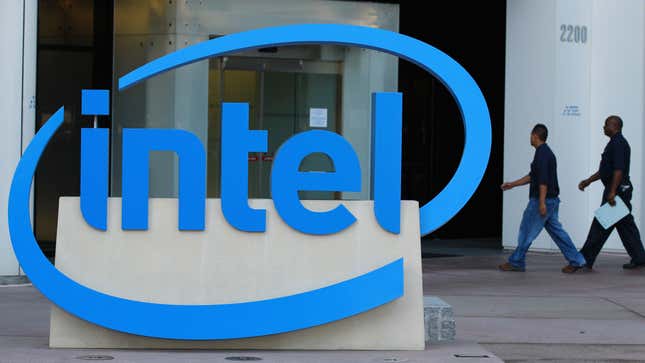
Intel is breaking up, rather than simply cutting, its graphic chips unit.
Yesterday (Dec. 22), the company said it’s splitting its accelerated computing systems and graphics group, abbreviated as AXG, into two. One arm, responsible for the development of discrete Graphics Processor Units (GPUs), will slot under Intel’s client computing group. The other, high-performance computing (HPC) accelerators, will join its data center and artificial intelligence business.
The restructuring of the graphics chips business signals Intel’s intention to renew efforts to take on Nvidia and Advanced Micro Devices (AMD). The market leader in integrated GPUs—where the graphics card is part of the CPU, a product where Intel also leads—has failed to make a mark in the discrete GPU (dGPU) space.
Charted: Nvidia is winning in dGPUs
Intel trails Nvidia in discrete graphics cards
The AXG group, formed in 2016, has so far guzzled $3.5 billion with little to show for it—especially when it comes to the development of dGPUs, which has been growing in demand among PC and laptop gamers, and has several other use cases in banking, automotives, and more.
Intel’s foray into graphics cards earlier this year, after a 24-year-hiatus from the space, didn’t go smoothly—software problems crippled its hardware sales. It remedied the code causing the snag, and is not looking to get an even bigger piece of the discrete graphics card pie.
Intel not only continues to be overshadowed by market leader Nvidia, but it’s also struggling to match semiconductor company AMD, the rapidly rising innovator.
In July, analyst Jon Peddie said Intel should probably dump the AXG group as part of its austerity measures. In the six years since it was formed, “AMD and Nvidia have brought out three generations of new and stunningly powerful dGPUs, and more are in the pipeline. Four new companies have started up in China, and two new ones announced in the US. Intel is now facing a much stronger AMD and Nvidia, plus six start-ups—the rules of engagement have dramatically changed while Intel sunk money into projects it can’t seem to get off the ground,” Peddie wrote in his blogpost.
But it doesn’t look like Intel is axing the business just yet. “Discrete graphics and accelerated computing are critical growth engines,” it said yesterday. “We are evolving our structure to accelerate and scale their impact and drive go-to-market strategies with a unified voice to customers.”
Person of interest: Raja Koduri
Raja Koduri came to Intel in 2017, armed with experience from iPhone maker Apple and chips company AMD. Most recently, he was leading the graphic chips unit that was just bifurcated and reorganized. With the recent shakeup, he’s poised to return to his role as chief architect to oversee the company’s long-term technology and chip design strategy.
One more thing: Intel and other chip makers are struggling
Intel, which plans to cut $10 billion in costs through 2025, has had to make some tough calls in the middle of “continued macroeconomic headwinds.” In the middle of 2022, it shut down its Optane memory, suffering a $559 million inventory write-off in the process. Come early 2023, it will lay off 200-odd employees.
Chipmaker Micron Technology announced yesterday (Dec. 21) that it will lay off 10% of its staff and cut spending as it falls prey to several headwinds including high inflation, rising interest rates, geopolitical tensions and China’s covid policies, and more.
Related stories
👨💻 Gamers are going to great lengths to find graphics cards in a chip shortage
📌 How Intel became Biden’s main marketing tool for the US innovation bill